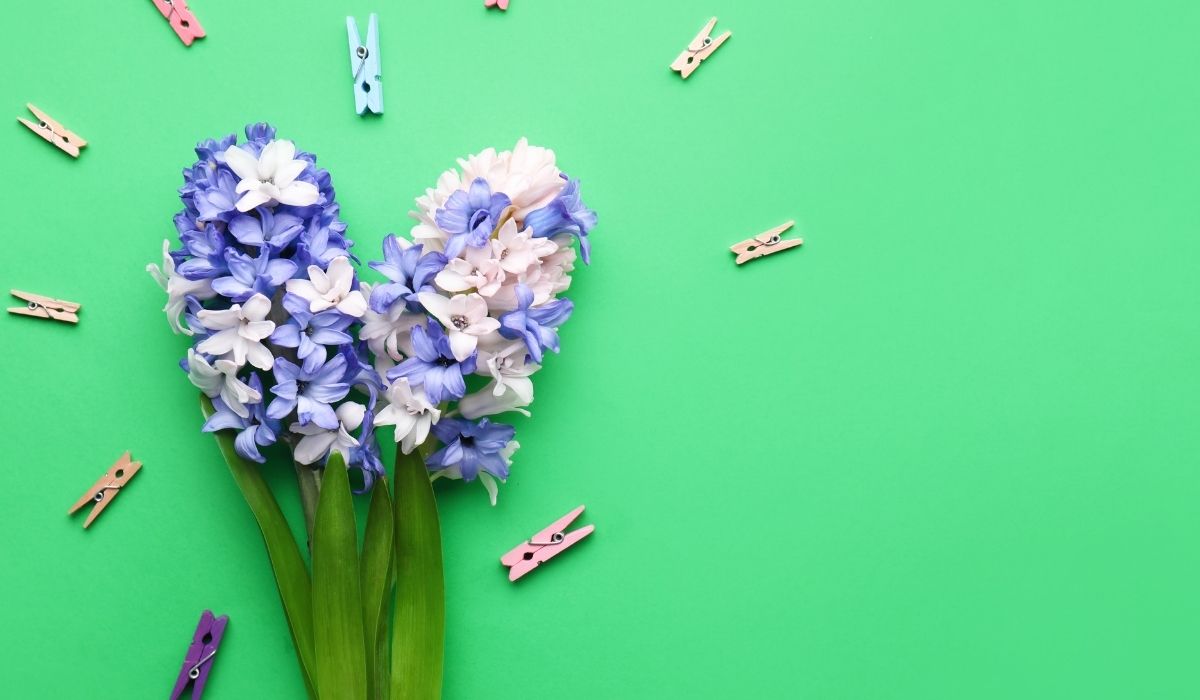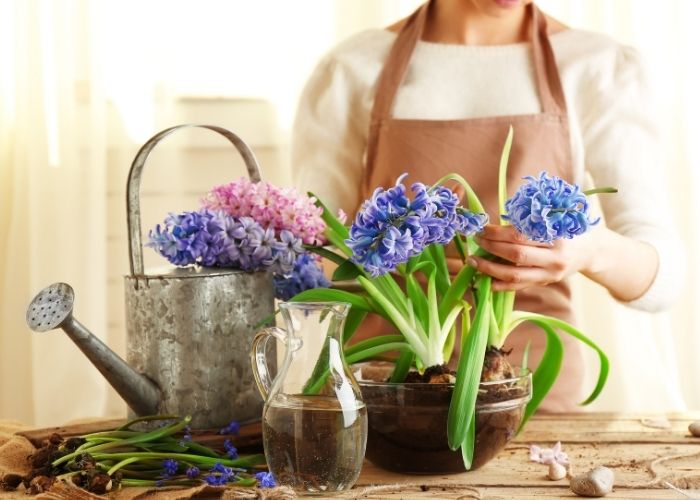Last Updated on January 15, 2023 by Urska
Hyacinths are beautiful plants that are amongst the favorites of many gardeners, but new gardeners often wonder when to plant hyacinths. We’re here today to tell you that these plants aren’t difficult to plant nor to care for. Their flowers are absolutely beautiful and they release a very intoxicating, fine smell. Let’s dive right into the world of hyacinths!
General Information
Hyacinths usually have a violet, sometimes a pale blue flower. However, you can nowadays find them in many colors, ranging from pink to white, because of selective breeding. They usually stand at eight inches and develop a very strong scent!
Many people mix Grape Hyacinths with hyacinths. These plants aren’t exactly related to original hyacinths, but they also bloom in the middle of the spring.
These plants develop a very pleasurable scent!
When And How To Plant Hyacinths
Hyacinths aren’t difficult to plant at all!
It’s best to plant them in autumn, anything from middle to late autumn will do.
Experts say that the rule of thumb is the frosts! You should plant them after the first frost, but before the ground completely freezes. Some people wonder can you plant hyacinths in the spring. It’s best not to, as they won’t grow as nearly as successful as they would if they were planted in autumn.
When you’re planting hyacinths, make sure to set them apart from one another by at least 5 inches. You should dig holes to the depth of at least 4 inches! Some gardeners plant each bulb individually, while others dig out a larger area and plant many bulbs together. This hyacinth growing zone will, in either case, be fully purple once the flowers bloom. Make sure you point the pointy end of the bulb towards the sky before you cover the bulb with soil.
Regarding group planting vs individual planting; some gardeners claim that it’s best to plant hyacinths in groups of 5 to 9 bulbs. This gives the groups more of a natural feel, as they wouldn’t really grow in a straight line in the wild.
These plants don’t need too much water, so only water them if the weather is really dry. Your average amount of moisture and rain should take care of it.
Where To Plant Hyacinths
Hyacinths are beautiful plants of wonderful coloring, so they can really be a great addition to any part of your home. However, many professional gardeners have their favorite spots to plant these beautiful plants in.
Walkways and flower beds are sometimes on the top of those lists. If you plant them near a walkway, everyone walking by will smell the scent (it’s so strong, it’s impossible to ignore). It also gives a beautiful contrast to other flowers. Try to pair it with yellow flowers, as they often make for a great combination.
Planting them into containers is also a great choice. Pots are a great option, and it’s very easy to move the pot to a more obvious location where more people can see the plant in its bloom!
Caring for Hyacinths
These plants aren’t that difficult to look after, which can make them a great plant for beginners! There are still a few important things to keep your eye on.
The number one thing is watering. These plants are vulnerable to overwatering and they do not like to be watered in excess. It’s best to water them once the soil is completely dry. If you’ve planted your hyacinths outside, then let the weather do the work – it’s best to water them only if you’re experiencing a particularly dry season.
When you’re watering the plant, it’s best to water directly to the root, not over the plant. This will minimize the risk of disease and rot.
Experts say that hyacinths don’t need fertilizer to grow into beautiful plants. You can, if you’d like, use commercial organic fertilizer to sprinkle it on the soil, but it isn’t necessary.
When it comes to making it through the winter, it’s best to move your plants to a sheltered area. This is possible only if you planted them in pots or containers (unless you’re planning on replanting them). If moving them isn’t possible, then you can cover them.
These plants aren’t prone to diseases too much, but they are prone to developing grey mold and rot if you overwater them. This is why it’s so crucial to keep them dry when necessary!
It’s perhaps important to note that these plants are poisonous to animals, so if you have a curious dog or a cat in your yard, you might want to rethink planting them. They can easily cause trouble with breathing and stomach issues. This can also happen with small children, not only dogs.
Blooming And Aftercare
Once the blooming period has passed and your hyacinths are done with flowering, it’s best to remove the blooms without removing the foliage. The reason you want to keep the leaves is that the leaves are needed for the bulbs to collect energy. Once the spring season ends, you’ll see that the foliage is dying on its own. Once the leaves turn brown completely, feel free to remove them to prevent diseases.
If you’re keeping your plants indoors, you can just take your hyacinths to your garden once they’re done with blooming. You want to keep them outside in the sun to collect energy. Follow the same steps with dried-out foliage before storing them for the winter.
To sum up, hyacinths are beautiful plants that bloom in mid-spring and it’s best to plant them in mid to late autumn. These plants let off a powerful, yet beautiful scent that’s very easy to sense. They’re not difficult to care for at all, with the most important thing is watering. It’s important not to overwater these plants as that can cause them to rot easily. Hyacinths can grow both inside and outside, and they can make it through the winter by either being stored away or covered. Caring for them once the blooming period ends isn’t complicated at all, which makes these plants ideal for beginners.
Read more about Are Iris Deer Resistant?




